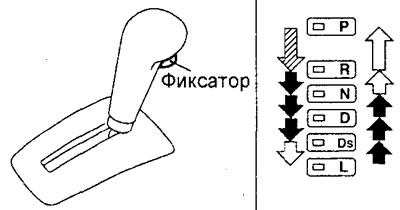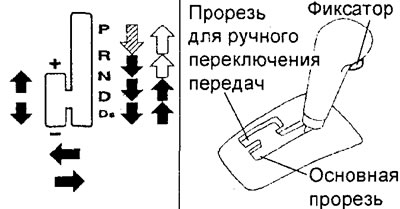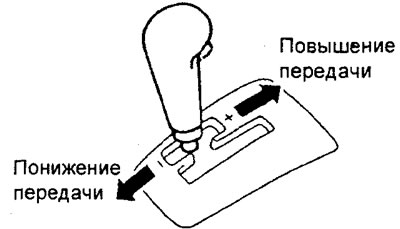Selector position
1. To control the variator, a selector is installed on the center console, on the side of the driver. The selector is connected to the variator by a cable and can be used to set the variator operation mode.
2. To prevent damage to the variator if the range is incorrectly selected (for example, moving from "D" V "R" when moving forward) a lock is installed on the selector, only when pressed, it is possible "dangerous" switching. The latch allows you to avoid a situation where, through negligence, one of the invalid ranges of motion can be switched on.

CVT without manual shift mode (selector can be set to position: "R", "R", "N", "D", "Ds", "L").

CVT with manual shift mode (selector can be set to position: "R", "R", "N", "D" or "Ds").
Position "R"
It is selected when the car is parked for a long time. In this position of the selector in the variator, all controls are turned off, and its output shaft is blocked; vehicle movement is not possible. To move the selector to this position is permissible only at a complete stop. Move selector to position "R" while driving will damage the variator.
Position "R"
Reverse. The selector can only be moved to this position when the vehicle is stationary. Translation of the selector into position "R" while moving forward, it can lead to failure of the variator and other transmission elements.
Position "N"
Corresponds to neutral. In the variator, all controls are turned off, which ensures the absence of a rigid kinematic connection between its drive and driven shafts. In this case, the output shaft blocking mechanism is disabled, i.e. the car can move freely.
It is not recommended to move the selector to the position "N" while coasting (by inertia). Never turn off the ignition when driving downhill. This practice is dangerous because it could cause you to lose control of the vehicle.
Position "D"
Basic driving mode. It provides forward movement. In normal driving conditions, it is recommended to use it.
Position "Ds"
This mode is recommended for dynamic driving and better engine braking on slopes.
Position "L"
This range allows maximum implementation of the engine braking mode. It is recommended when driving on steep descents, climbs and off-road.
Notes on driving a vehicle with a CVT
1. Do not press the accelerator pedal when braking (brake pedal pressed) or when moving the selector from the position "R" or "N" to the driving position, as this may damage the transmission.
2. Always depress the brake pedal when moving the selector out of position "R" or "N" to driving position ("R" or "D").
3. At short stops (before a traffic light, etc.) you can leave the car in gear and hold it in place by depressing the brake pedal. For long stops, move the selector to the position "N".
4. Do not hold the vehicle on a slope by depressing the accelerator pedal while in gear. Step on the brake pedal or apply the parking brake.
5. After connecting the battery wires, gear shifting may be jerky. This is not a sign of a transmission problem. Gear shifting will become smooth after a certain period of time, during which the CVT control system will make several gear shifts.
6. (Manual Shift Models) When the ignition is turned on, the indicator on the instrument cluster lights up, corresponding to the position of the variator selector.
7. After a long period of parking at low outside temperatures (-35°C or less) it may be difficult to start the car, even if the selector is in the position "D". Leave the engine running for 10 minutes or more to warm up the CVT fluid.
8. Before engaging a gear in manual mode ("Sport Mode") With the vehicle stationary and the engine running, fully depress the brake pedal to prevent the vehicle from moving unexpectedly. Release the brake pedal only when ready to move.
CVT manual shift mode
1. The center console has two slots in which the CVT selector moves: main slot (see subsection "Selector positions") and slot for manual shifting. Regardless of whether the vehicle is in motion or stationary, the transition to manual gearshift mode is made by moving the variator selector from the position "D" into the corresponding slot.
2. In manual mode, fast gear shifting is possible by moving the selector forward (+) or back (-). With each movement, a correspondingly higher or lower gear will be engaged. Unlike a manual transmission, manual mode allows you to shift gears while pressing the accelerator pedal.
Attention: smoothly, without undue effort, move the selector between the slots in the console and between different positions. Otherwise, the selector may be damaged.
Note:
- In manual mode, only one of the forward gears can be engaged.
- When switching to manual gearshift mode, the indicator "D" on the instrument cluster will go out and the indicator will light up "1". Further, when shifting gears, the indicator corresponding to the selected gear of the gearbox will light up.

3. In manual mode, there is no automatic upshifting. The driver must himself engage the overdrive in accordance with road conditions and engine speed.
